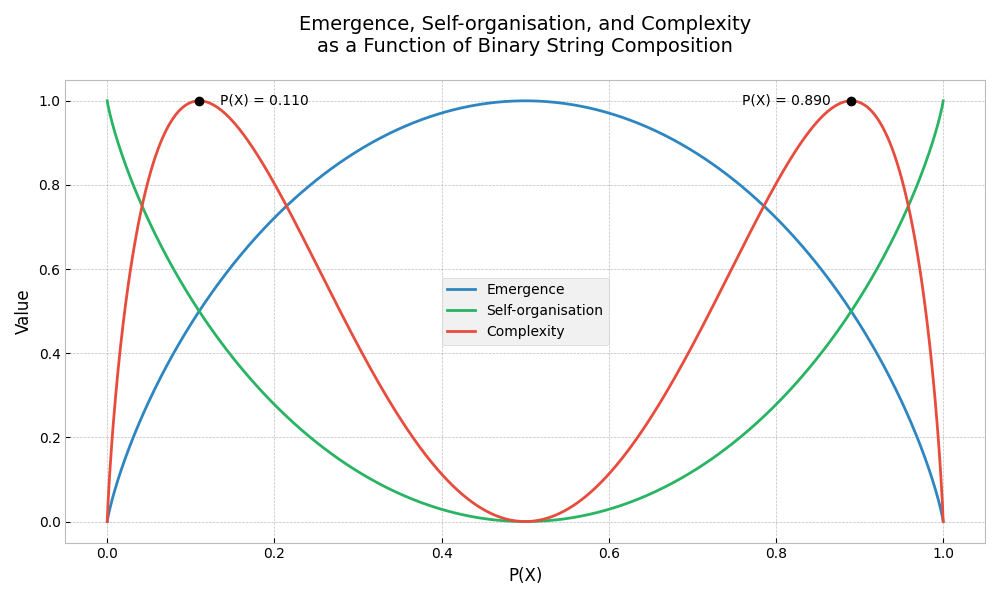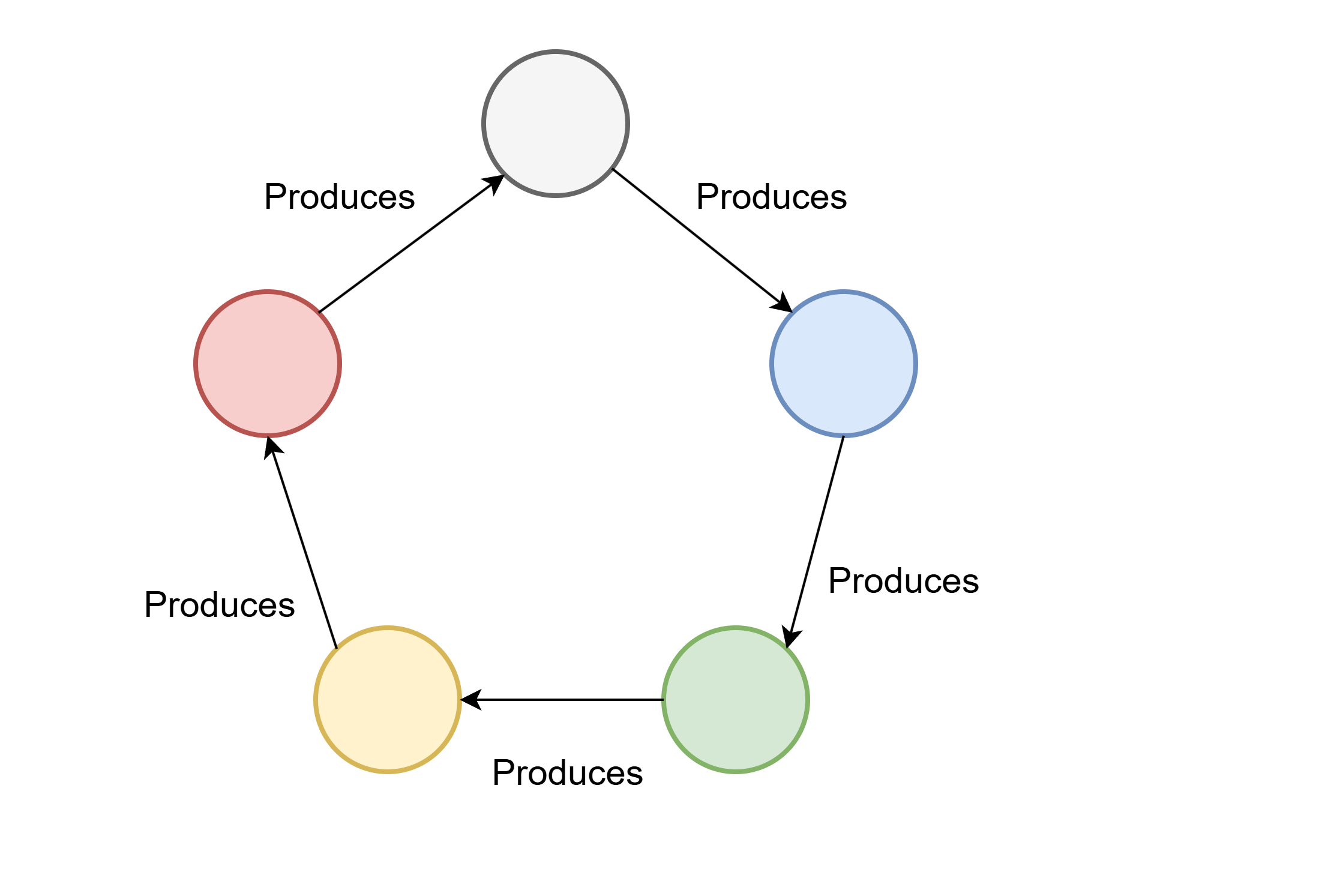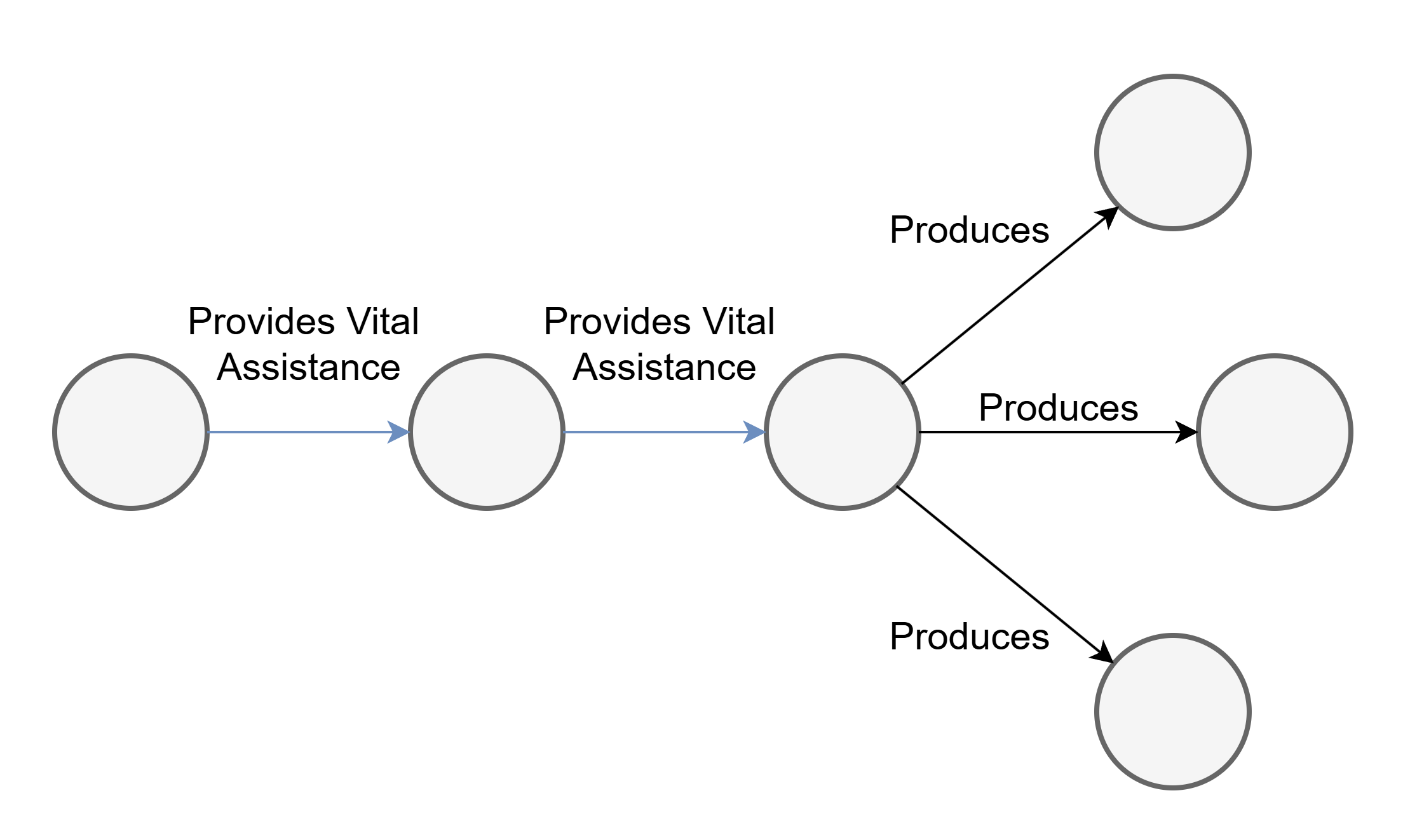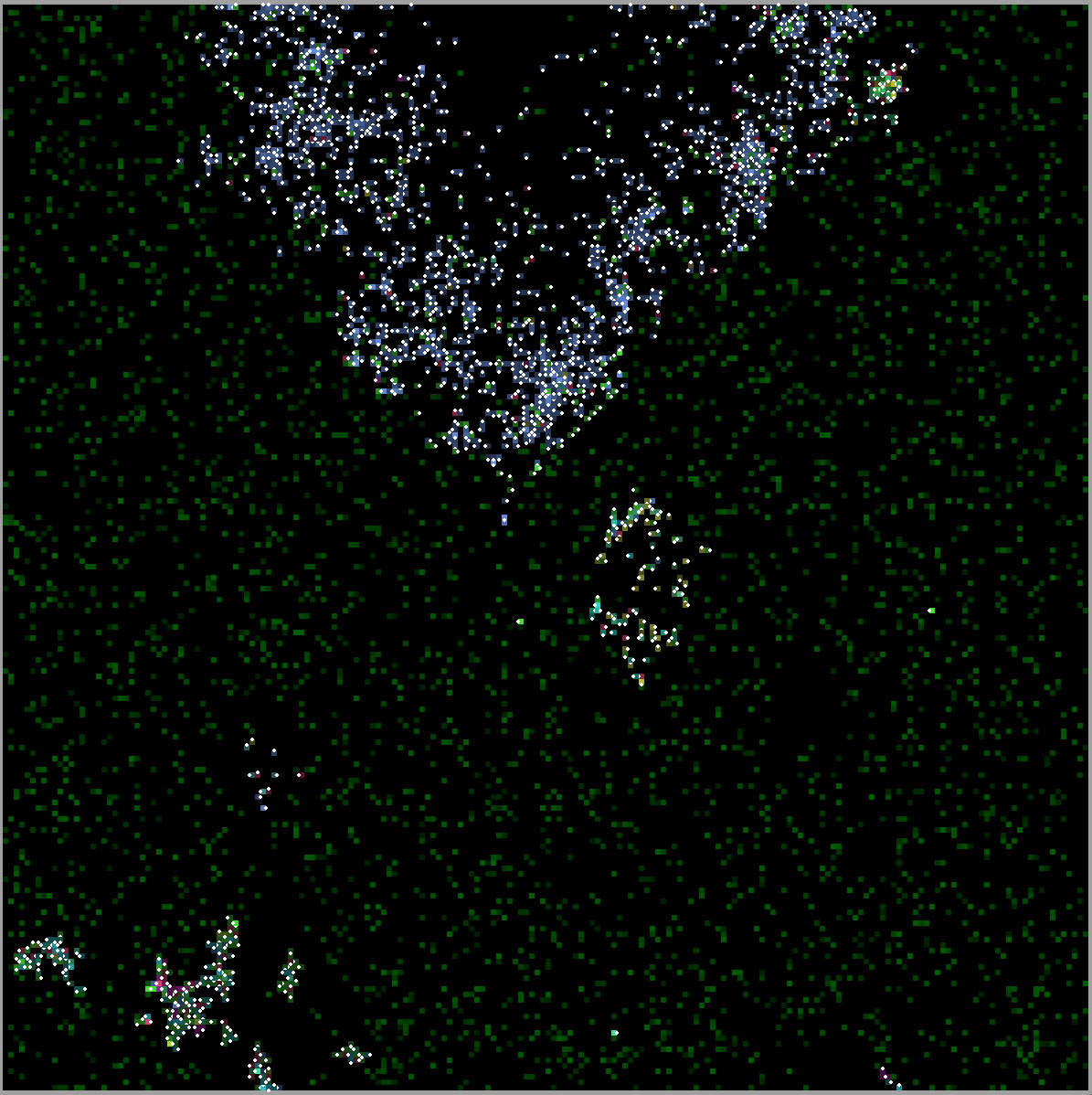Abstract
Previous attempts to replicate Darwinian evolution through artificial life simulations (ALife worlds) have struggled to achieve open-endedness or evolve population-level complexity. We suggest this limitation stems from allowing agents to survive and reproduce independently, inadvertently precluding the evolution of sophisticated collective behaviours. We propose the Interdependence Condition (IC): that agents must depend upon emergents arising at the population-level to satisfy their replication criteria reliably—a condition for encouraging population-level dynamical complexity.
We introduce the Myxomatrix, an ALife world inspired by plasmodial slime moulds, and test the hypothesis that individualistic agents struggle to develop collective complexity by comparing IC-compliant and non-compliant variants. In the IC-compliant variant, agents evolve collective behaviours, progressing from Blobs to Crawlers to Sweepers, and ultimately to Switchers—populations exhibiting perception-decision-action loops that exist only at the group level and are inaccessible to the individuals, which we term superagency.
These superagents develop adaptive search strategies and altruistic inter-lineage mass transfer. Conversely, in the non-compliant variant, agents typically maintain individualistic strategies (Movers) even when collective behaviours are mechanically possible, accessible through minor mutation, and demonstrably advantageous. These results suggest that the IC provides a framework for designing ALife worlds that better approximate the complexifying creative power of Darwinian evolution.
Note: This is a highly abbreviated version of the full research paper. For complete methodology, detailed results, comprehensive analysis, and full references, please download the complete PDF version.
1. Introduction
Evolution by natural selection, or Darwinian evolution, explains life's prodigious diversity and complexity in terms of differential survivability of genetic information, encoded within imperfect replicators, over generational time. Beginning with relatively simple prebiotic chemistry, Darwinian evolution has progressively innovated and integrated prior innovations as components of new ones at larger scales.
This process has gradually given rise to the highly stratified complexity we observe in the biosphere today, from organic chemistry to organelles, cells, bodies, and social groups. These successive organisational levels facilitate emergent capabilities: metabolic regulation in organelles, motility in cells, sensorimotor integration in multicellular organisms, and distributed cognitive processes in social groups such as eusocial insect colonies.
Artificial life (ALife) researchers aim to replicate this phenomenon through Darwinian ALife worlds, simulated environments populated with agents that (imperfectly) replicate, and compete for the prerequisite resources to do so. However, existing ALife worlds have struggled to achieve the open-endedness and evolution of life-like complex dynamics and intelligence that characterise natural evolution.

2. Emergence, Self-Organisation, and Complexity
In large-scale systems with many interacting components, complexity can be understood as an equilibrium of two opposing phenomena: emergence, where novel information not present at the micro-level arises at the macro-level through interactions among micro-level components; and self-organisation, where systems autonomously develop robust order (i.e., repeated and sustained information).
The natural world abounds with examples of complexity in this sense. Many small elements, through their interactions distributed among the population, give rise to a gestalt entity, such as cells emerging from organic molecules, representing the generation of information that is novel with respect to the molecules. These entities are then reproduced to form new populations at higher scales—demonstrating self-organisation through the recurrence of information.
3. ALife Worlds
ALife worlds are computer-simulated environments where programs or agents with genetically encoded control mechanisms compete to survive and (near-perfectly) replicate in a shared and (approximately) spatially and temporally continuous environment. Selection pressures arise endogenously in the absence of an explicit fitness function, attempting to reproduce life-like systems through (approximately) Darwinian evolution in silico.
Existing ALife worlds include Tierra, Avida, and Evita, which modelled programs with mutable instructions. Geb modelled neural-network-controlled agents and was the first model to be classified as unbounded using activity statistics. PolyWorld and the more recent Bibites attempt to approximate nature more closely with animal- or cell-like agents roaming a 2D plane, foraging for plants to sustain themselves.
4. What's Missing in ALife Worlds?
Early artificial life simulations made remarkable progress in evolving agents that exhibit animal- or cell-like behaviours, establishing foundational approaches for facilitating and measuring evolutionary emergence. However, compared with the natural world, ALife worlds are distinctly lacking in complexity in the sense of a confluence of emergence and self-organisation made manifest in the environment through interactions amongst populations.
We propose that ALife agents might be better understood as 'genetic agents': expression mechanisms, analogous to the molecular machinery that stores and translates genetic information into phenotypic effects on Earth. This re-framing suggests an interesting direction for expanding current ALife approaches, drawing inspiration from theories of life's origin based in autocatalysis.
5. The Interdependence Condition (IC)
Based on the hypothesised role of the replicator-reproducer distinction in the emergence of biological complexity on Earth, we propose the Interdependence Condition (IC) for scaffolding the evolution of population-level complexity in ALife worlds:
Agents must depend upon emergents arising through interactions amongst populations of agents and elements of the environment to satisfy their replication criteria reliably.
In other words, populations of agents are networked by dependence relationships, and independent strategies are not viable.


We hypothesise that the crucial feature of such systems is not the specific topology of dependencies, but rather the reliance on population-level emergents. When populations depend on emergent properties, mutations at the individual level can precipitate significant changes in population-level dynamics. This mechanism provides three essential features:
- Mutable emergence generates novel information that is inherently relevant to survival and replication
- Selection pressures ensure only information advantageous to survival persists and is replicated, fostering self-organisation, and therefore complexity
- Complexity, novel but somewhat predictable information, provides novel opportunities for innovation, potentially including new emergents at higher scales
6. The Myxomatrix
We introduce the Myxomatrix, a novel ALife world designed to test the IC and demonstrate population-level complexity evolution in a visually interpretable manner. The simulation draws inspiration from plasmodial slime moulds, which are large multinucleate single-celled organisms that exhibit emergent swarm intelligence through the coordinated actions of many nuclei distributed throughout their cytoplasm.
The Myxomatrix operates on a 2D cellular grid where each cell may contain both a plant and an agent. Agents must consume plants to acquire mass, which gradually depletes at a rate proportional to their controller network complexity. A crucial constraint is that agents cannot move from their birth cell—only replicate into neighbouring cells and transfer mass to existing neighbours.

Consequently, effective environmental exploration requires agents to develop coordinated replication and mass transfer strategies that culminate in efficient traversal and effective search patterns at the population-level. This design satisfies the IC through dependency chains between agents.
7. Results
Our experimental results provide strong support for the Interdependence Condition as a framework for scaffolding the evolution of population-level complexity in artificial life systems. The reliable emergence of superagency in the IC-compliant Myxomatrix demonstrates that enforced agent interdependence can successfully guide evolutionary processes toward increasingly sophisticated collective behaviours.
7.1 IC-Compliant Myxomatrix
In the IC-compliant variant, agents consistently evolved through distinct phases:
- Blobs: Initial erratic replication and transfer patterns creating expanding blob-like formations
- Crawlers: Streamlined single-agent chains that replicate forward and transfer mass efficiently
- Sweepers: Diagonal formations of crawler-like lineages that provide more thorough local search
- Switchers: Advanced populations exhibiting adaptive search strategies and altruistic mass transfer between lineages



7.2 IC-Non-Compliant Myxomatrix
In the non-compliant variant, agents could move independently between cells. This modification created movement-based equivalents to all replicate-and-transfer-based strategies, effectively relaxing the IC. Agents in this variant typically developed individualistic "Mover" strategies, maintaining independent traversal patterns even when collective behaviours were mechanically possible and demonstrably advantageous.
7.3 Superagency
The most significant finding was the emergence of "superagency" in IC-compliant populations. Switchers demonstrated perception-decision-action loops that existed only at the group level, including:
- Adaptive search pattern selection based on resource distribution
- Altruistic mass transfer between lineages
- Coordinated exploration and exploitation strategies
- Dynamic formation and reformation of collective structures
These capabilities were inaccessible to individual agents and emerged purely through population-level dynamics, representing genuine collective intelligence.
8. Discussion
The success of the IC in scaffolding the evolution of complexity offers useful insights for designing future artificial life systems. By preventing agents from developing purely individualistic strategies, the IC maintains population-level emergent properties that promote the evolution of collective behaviours.
The findings suggest that the absence of complex population-level dynamics in previous artificial life systems may be partially attributed to their initialisation with independently viable agents. When individuals can survive and reproduce without relying on population-level emergent properties, they appear to actively resist evolutionary pathways that could lead to sophisticated collective behaviours.
9. Conclusion
Our experimental results provide strong support for the Interdependence Condition as a framework for scaffolding the evolution of population-level complexity in artificial life systems. The reliable emergence of superagency in the IC-compliant Myxomatrix demonstrates that enforced agent interdependence through emergent dynamics can successfully guide evolutionary processes toward increasingly sophisticated collective behaviours.
These results help us understand how collective behaviours can emerge through evolution and provide a practical approach for creating artificial life systems that more consistently develop sophisticated population-level dynamics. The IC offers a promising direction for future research into open-ended evolution and the development of truly complex artificial life systems.
10. Future Work
Future research should explore the IC's effects across fundamentally different implementation approaches, including heterogeneous environments and individual-level analysis. The framework provides a foundation for investigating whether sophisticated individual-level capabilities can coevolve with population-level complexity in IC-compliant systems.
Note: This is a highly abbreviated version of the full research paper. For complete methodology, detailed results, comprehensive analysis, and full references, please download the complete PDF version.